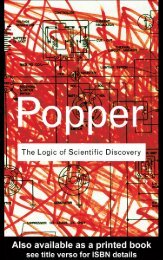Create successful ePaper yourself
Turn your PDF publications into a flip-book with our unique Google optimized e-Paper software.
HOW PEIRCEAN WAS THE “‘FREGEAN’ REVOLUTION” IN LOGIC? 35<br />
“On the Logic of Relatives” [1883, 200], we have: “�i �j li,j ��� means that everything is a lover of something.” The<br />
quantifiers run over classes, whose elements are itemized in the sums and products, and an individual for Peirce is one<br />
of the members of these classes.<br />
Despite this, singular propositions, especially those in which definite descriptions rather than proper names,<br />
have also been termed “Russellian propositions”, so called because of their designation by Bertrand Russell in terms of<br />
the iota quantifier or iota operator, employing an inverted iota to be read “the individual x”; thus, e.g. (�x)F(x) (see<br />
[Whitehead & Russell 1910, 32]), (see [75, p. 32]), and we have, e.g.: “Scott = (�x)(x wrote Waverley)”. 42 In Principia<br />
Mathematica [Whitehead & Russell 1910, 54], Russell writes “f!x” for the first-order function of an individual, that is,<br />
for any value for any variable which involves only individuals; thus, for example, we might write m!(Socrates) for<br />
“Socrates is a man”. In the section on “Descriptions” of Principia [Whitehead & Russell 1910, 180], the iota operator<br />
replaces the notation “f!x” for singulars with “(�x)(Φx)” so that one can deal with definite descriptions in as well as<br />
names of individuals. This is a great simplification of the lengthy and convoluted explanation that Russell undertook in<br />
his Principles of Mathematics [Russell 1903, 77–81, §§76–79], in order to summarize the points that: ‘“Socrates is aman”<br />
expresses identity between Socrates and one of the terms denoted by a man’ and ‘“Socrates is one among men,”<br />
a proposition which raises difficulties owing to the plurality of men’ in order to distinguish a particular individual<br />
which is an element of a class having more than one member from a unary class, i.e. a class having only one member.<br />
§3. How much, if anything Peirce and Frege knew of, or influenced, the other’s work. In the “Preface” to the<br />
English translation [Couturat 1914] Algebra of Logic of Couturat’s L’algèbra de la logique [Couturat 1905] by Philip<br />
Edward Bertrand Jourdain (1879–1919) summarized what he considered to be the true relation between the algebraic<br />
logicians on the one hand and the logisticians, Frege, Peano, and Russell on the other, writing [Jourdain 1914, viii]:<br />
We can shortly, but very fairly accurately, characterize the dual development of the theory of symbolic logic<br />
during the last sixty years as follows: The calculus ratiocinator aspect of symbolic logic was developed by<br />
BOOLE, DE MORGAN, JEVONS, VENN, C. S. PEIRCE, SCHRÖDER, Mrs. LADD-FRANKLIN and others; the lingua<br />
characteristica aspect was developed by FREGE, PEANO and RUSSELL. Of course there is no hard and fast<br />
boundary-line between the domains of these two parties. Thus PEIRCE and SCHRÖDER early began to work at the<br />
foundations of arithmetic with the help of the calculus of relations; and thus they did not consider the logical<br />
calculus merely as an interesting branch of algebra. Then PEANO paid particular attention to the calculative aspect<br />
of his symbolism. FREGE has remarked that his own symbolism is meant to be a calculus ratiocinator as<br />
well as a lingua characteristica, but the using of FREGE’s symbolism as a calculus would be rather like using a<br />
three-legged stand-camera for what is called “snap-shot” photography, and one of the outwardly most noticeable<br />
things about RUSSELL’s work is his combination of the symbolisms of FREGE and PEANO in such a way as to<br />
preserve nearly all of the merits of each.<br />
As we in turn survey the distinguishing characteristics of mathematical logic and, equivalently, enumerate the<br />
innovations which Frege was the first to devise and, in so doing, to create mathematical logic, we are led to conclude<br />
that many, if not all, of these were also devised, to greater or lesser extent, also Peirce, if not entirely simultaneously,<br />
then within close to the same chronological framework. One major difference is that Frege is credited, for the greater<br />
part correctly, with publishing nearly all of the elements within one major work, the Begriffsschrift of 1879, whereas<br />
Peirce worked out these elements piecemeal, over a period that began in or around 1868 and over the next two decades<br />
and beyond, in widely scattered publications and unpublished manuscripts. From Peirce’s biography, we can extract<br />
the explanation; that his time and efforts were distracted in many directions, owing in no small measure to his personal<br />
circumstances, and to a significant degree as a result of his lack of a long-term academic position.<br />
Beyond this explanation, we are led to also inquire to what extent, if any Peirce was influenced by Frege, and<br />
also whether Frege was influenced by Peirce, and, in both cases, if so, to what extent. So far as I am aware, the most<br />
recent and thoroughgoing efforts to deal with these questions are to be found in [Hawkins 1971; 1993; 1997, 134–<br />
137]. It is therefore useful to apply the evidence that [Hawkins 1971; 1993; 1997, 134–137] provides in order to understand<br />
how “Peircean” was the “Fregean” <strong>revolu</strong>tion.<br />
The short answer is that there is strong circumstantial evidence that Peirce and his students were well aware of<br />
the existence of Frege’s Begriffsschrift beginning at least from Peirce’s receipt of Schröder’s [1880] review of that<br />
work, but it is uncertain whether, and if so how deeply, Peirce or his students studied the Begriffsschrift itself; but most<br />
likely they viewed it from Schröder’s [1880] perspective. It is unclear whether Schröder and met Peirce met during





